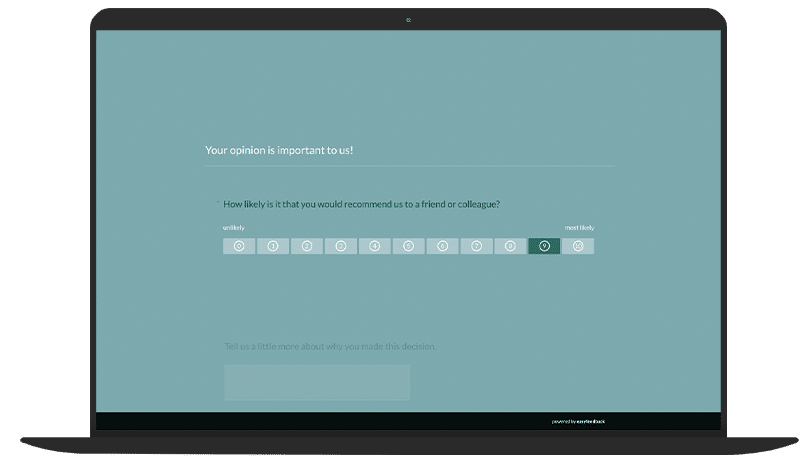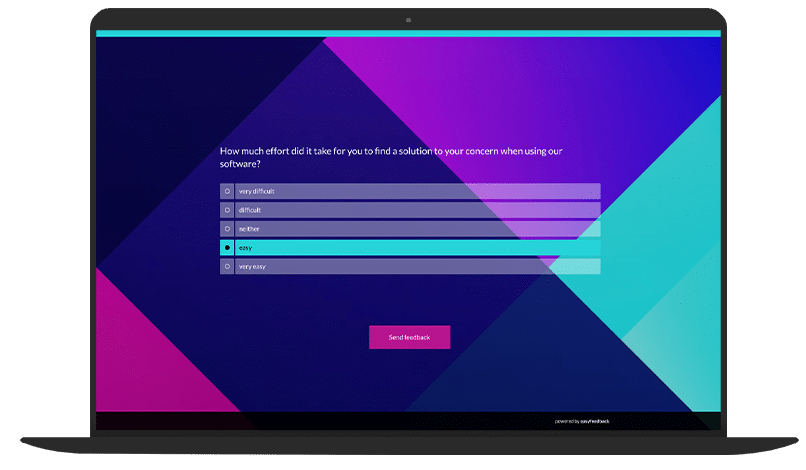Why is measuring customer experience important?
Before we get started with the explanations of possible metrics, let’s briefly discuss why it is important to continuously measure the customer experience.
In an ever-growing competitive landscape, it’s not just technological capabilities, price leadership or brand awareness that are relevant.
A customer’s experience along their journey with the company also plays a very important role.
A thoroughly positive customer experience leads to customer satisfaction and customer satisfaction in turn leads to loyalty.
According to a study by PwC , 73% of consumers remain loyal to a company/brand if they experience a positive customer experience.
They would also be willing to pay more for a product. In other words, loyalty pays off economically.
Loyal and satisfied customers are almost always repeat buyers, positively recommend a company and its products to others, and are more tolerant of problems, such as delivery delays or short-term inaccessibility of online tools.
Moreover, the cost of acquiring new customers is significantly higher than retaining existing ones.
Therefore, it makes sense to invest not only in product and brand leadership, but also in positively shaping the customer experience along the customer journey and constantly optimizing it to meet new requirements and wishes.
What are the metrics for measuring customer experience?
So, why measuring customer experience is important, we discussed in the chapter before. Now we know what metrics we can use to measure and monitor the customer experience.
So let’s start directly with the first metric:
1. Referral Rate (Net Promotor Score)
Net Promoter Score (NPS) or referral rate is one of the most well-known metrics to measure customer satisfaction and experience.
As the term suggests, it’s all about one question:
“How likely are you to recommend our company to a friend or colleague?”
This question is answered by participants as standard using a scale of 0 (very unlikely) to 10 (very likely).
From the feedback received on the willingness to recommend and the calculation of the NPS score, it can be concluded at the end whether the customers are satisfied with your company or whether you may have to fear that customers will leave due to their dissatisfaction and it may become more difficult for you to acquire new customers.

2. Customer Effort Score (CES)
The second metric you can use to measure the customer experience is the customer effort score (CES).
The CES provides information on how much effort, for example, a customer had to expend while using a product, ordering a tariff or dealing with customer service in order to initiate improvements based on the results.
On a scale of 1 (extremely easy) to 7 (extremely difficult), the customer gives his or her impression.
At the end, the answers and the CES score can be used to determine whether there is potential for improvement in order to reduce the customer’s effort for a particular interaction and increase satisfaction through suitable measures.

3. Customer Satisfaction Score (CSAT)
If you want to easily survey customer satisfaction in a specific area of your business, with your products or services, at regular intervals, you can do this with the Customer Satisfaction Score (CSAT).
The CSAT allows you to flexibly survey satisfaction at many points along the customer journey. An example of this is a CSAT survey on the ordering process or on new functions of an online tool.
Customers can rate their satisfaction on a scale from 1 (very dissatisfied) to 5 (very satisfied).
The score you receive tells you where there are weak points in your customer journey and where you need to make improvements. In addition, the Customer Satisfaction Score supports you in the targeted management of your resources.
It’s no use focusing your resources on what’s already going well, but on what needs to be improved.

4. Customer churn rate
When customers leave, this is usually an indication that something is wrong with your company or your product. However, you don’t have to accept this as it is; instead, you can actively analyze the reasons for customer churn using the churn rate.
The churn rate describes the ratio between the total number of lost customers and the total number of active customers for a given period.
This metric gives you an early indication of whether your profitability and growth are suffering.
5. Customer retention rate (customer retention)
The counterpart to the customer churn rate is the customer retention rate.
The customer retention rate indicates the percentage of customers (excluding new customers) who did not churn but remained as customers within the measurement period.
With this you can find out how well your business is working or if you need to react. After all, the goal of a company should not only be to acquire new customers, but to retain them in the long term.
6. Things that went wrong (Things Gone Wrong)
The Things Gone Wrong (TGW) metric is a bit more unknown, however it has the charm that you don’t even have to do a survey for this one.
Things Gone Wrong describes the percentage of customer interactions where something went wrong.

So, for example, the proportion of complaints to the total amount of orders or the proportion of buyers who contacted support, but support could not help them solve the problem.
TGW is usually expressed as x out of 1,000 or x out of 1 million. However, the unit (100, 1,000, 10,000 …) can also be chosen by the user.
7. Customer value (customer lifetime value)
Customer retention is important. Existing customers help acquire new customers through their positive referrals, are more forgiving when problems arise, and are often repeat buyers.
With customer lifetime value (CLV), you can find out how much value a customer has over the lifetime of the customer.
Sound funny?
Then here’s another way to put it:
You determine how much revenue the customer has brought you so far and will bring you in the future.

For CX, this metric means: a high customer value can be justified with a good CX. A low customer value with a poor CX.
So for customer value to increase, you need comprehensive customer care and a positive customer experience.
8. Visitor behavior on your website
Today, a company’s website is its business card and often the first point of contact for potential customers along the customer journey.
If it is not convincing, your company/product will not be convincing either.
Therefore, it is important to measure the intention of your site visitors and how they move and behave on the website.
High bounce rates or low session durations are usually a sign that your website is not convincing.

9. Contact channel volume
This metric is quite simple to explain.
It tells you which channels (phone, email, social media, etc.) your customers are using to interact with you and, at the same time, which is the most popular.
With this information, you will not only know what your strongest interaction channels are, but also where your target audience is located in order to be more present with your marketing on these channels.
10. Average resolution time
The average resolution time expresses how quickly a customer’s problem was resolved by your company.
It is calculated by dividing the sum of all resolution times by the number of resolved issues in a given time period.
The faster you can solve a problem, the happier the customer is and the more positive their experience.
11. Other possible CX metrics
Well, now I’ve already presented you with 9 metrics to measure CX. But there are more. So that the article doesn’t get too long, I’ve briefly summarized for you the metrics that still need to be mentioned:
a. First Contact Resolution
First Contact Resolution is a simple metric that expresses how many customers have already resolved their problem/concern during the first contact with your company.
It helps you investigate whether service and support staff are using the right tools or if they need training.
b. Shopping cart abandonment rate
This metric helps you analyze if your order process is working as expected or if there are problems.
After all, nothing is worse for your business than when customers are ready to buy but then experience difficulties.
c. Sales figures
The goal of a company is economic success. And for economic success, sales are crucial. Sales figures, whether product or service, give you an indication of what the customer experience is currently like in your business.
If the number of sales is high, you are offering an excellent customer experience. If it is low, you should find the reasons for it.
Conclusion: One metric alone does not measure your complete CX
For long-term customer loyalty and to differentiate yourself more strongly from the competition, it is not necessarily necessary to be a technological pioneer, to have a high brand awareness or to be the cheapest on the market.
Offering a positive customer experience along the entire customer journey to keep customer satisfaction permanently at a high level is also an important relevant factor in competition.
In order to achieve this satisfaction, in addition to implementing measures to increase satisfaction, you should also permanently review all direct as well as indirect interaction points.
In this article, I have presented you with a lot of possible metrics that you can use to measure customer experience and satisfaction in different ways.
My tip to you:
Using one metric to measure and optimize CX is not enough. Multiple metrics in combination will give you a much more comprehensive picture of Customer Experience and Customer Satisfaction.
And one more thing:
Only use metrics that you need for your CX goals.
Permanently measuring and comparing all metrics can be costly. Pick the ones that fit your objectives and, based on the values and interpretations, start the optimization measures you need for a successful customer experience.
If you would like to learn more about the topic of customer experience, take a look at our other articles on the subject.
More about Customer Experience
- Everything you need to know about Customer Experience (CX)!
- Creating positive customer experiences with customer experience management
- 3 touchpoints in the customer experience (with video)
- Your way to an effective customer experience strategy!
- 10 methods to analyze the customer experience
- 12 practical examples for improving the customer experience
- Everything you need to know about the Net Promoter Score (NPS)!
- Customer Satisfaction Score (CSAT) – Measuring Customer Satisfaction differently
- Customer Effort Score (CES): How much effort do your customers have?
- Churn Rate: Key metric for measuring customer loyalty
- The Customer Satisfaction Index (CSI): A key to measuring customer satisfaction





